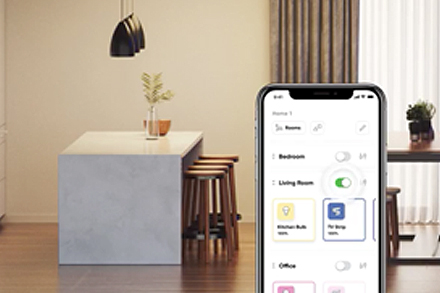Nanoleaf is a technology and IoT company changing the world with the most innovative smart home solutions, taking ordinary experiences and making them extraordinary. By infusing thoughtful design and technological intelligence in their products, Nanoleaf is ushering in a new era of the smart home that centers around complete personalization.
Launching into Apple stores worldwide, Nanoleaf Essentials are the first consumer smart lighting products to work with Thread, a low latency and low power IP mesh network.

THE CHALLENGE
With the development of its Essentials product line (A19 Light Bulb and Lightstrip), Nanoleaf wanted to make its products cost-competitive while also solving issues related to latency, which is critical in smart lighting. Compatibility with leading ecosystems such as Apple and Google was also a top priority.
Nanoleaf required a solution with improved reliability to support its Essentials line and lower power consumption to enable battery-powered devices in the forthcoming Learning Series, a lighting automation system that learns user habits. Device to device communication within Thread as well as from Thread to Wi-Fi was also an important requirement.

THE PROCESS
There were several factors that led Nanoleaf to select Thread for its Essentials line. First, Project Connected Home over IP (Project CHIP), backed by Amazon, Apple, Google and the Zigbee Alliance, is poised to bring interoperability to smart home devices and ecosystems as a unified connectivity standard built on IP. This new standard will run on select IP network transports – Thread for reliable and low power mesh, and Wi-Fi for higher bandwidth applications.
Since Apple's HomePodmini has HomeKit enabled over Thread, it allows for Thread devices to take full advantage of Apple-specific features like convenient control, advanced automations, and remote access. Later this year, Nanoleaf's own border routers will also enable smart devices such as Nanoleaf's Essentials line to directly connect to the internet without the need for a proprietary hub.
In selecting a low-power wireless network technology, Nanoleaf wanted their smart lighting devices to work with a broad set of ecosystems. Thread’s IP foundation is application layer agnostic, giving Nanoleaf the flexibility to do just that.

THE SOLUTION
In partnership with Apple, Nanoleaf developed the first consumer smart lighting products to work with HomeKit and Thread wireless connectivity.
Apple’s HomePod mini includes an integrated Thread radio and acts as a Thread “border router,” allowing it to serve as a bridge between a network of Thread-enabled smart devices and eventually the Internet. And Thread’s low-power mesh networking technology has the ability to self-heal – if one accessory becomes unavailable, data packets are automatically transmitted on an alternate route.
Users of Nanoleaf’s A19 Bulbs and Lightstrips are able to use both Bluetooth and Thread to connect and control smart home devices. By upgrading to Thread with a compatible border router (such as Apple’s HomePod mini, with many more coming in 2021), customers will experience the benefit of improved reliability, instant response time, increased range and longer battery life.

Competitive Advantage
Nanoleaf’s Essentials line of smart lighting products bring multiple benefits to consumers in combination with Thread:
- Instant Response Time – Thread networks have lower latencies with its direct device-to-device, device-to-mobile and device-to-cloud communications eliminating pauses that leave users hanging.
- Reliable – Makes dropped connections a thing of the past.
- Extended Range – More Thread-enabled devices throughout a home can extend the range and coverage of a network.
- Energy Saving – Thread-enabled products require less power and lower energy consumption.
